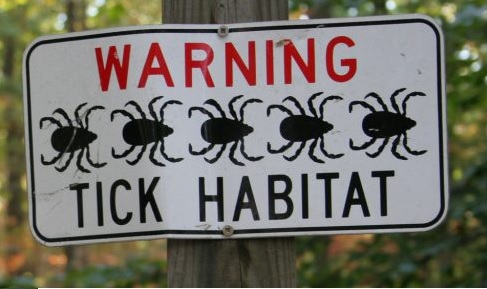
As the winter weather subsides and the warmer temperatures become more frequent, it becomes more likely that humans and pets may encounter ticks in their local parks and backyards. Unfortunately, certain tick species can transmit Lyme disease, which is very dangerous for humans and pets alike. So how can we protect ourselves, and our pets?
What is a Tick?
Ticks are wingless parasites of the arachnid family (spider-like creatures). Ticks are attracted to motion, warm temperatures (as generated from body heat), and exhaled carbon monoxide, hence making dogs, cats, birds, and humans viable targets. They wait on low vegetation, such as the tips of grass or shrubs, to attach to a suitable host. When the plant is brushed by an animal or person, the tick quickly lets go of the vegetation and climbs onto the host.
The Bite:
The tick’s bite is painless, so it is common for the tick’s presence to go unnoticed. They will remain attached to the host for several days, expanding to several times their original size. Ticks attach themselves to their host using their piercing mouthpiece. This feeding structure has backward pointing barbs, allowing it to maintain its grip while getting a blood meal. Once engorged, the tick releases itself from the host.
Tick Removal:
Any pet bitten by a tick should be examined by a veterinarian. To remove a tick, it is important to ensure that the entire tick is completely detached, including its head, which is usually embedded into the skin. Your veterinary doctor will use fine-pointed tweezers for this procedure, placing the instrument against the skin of your pet, and using a combination of a firm grip and steady pressure; pull the tick straight out (no twisting). It is important that the tick be grabbed by its head and not its swollen belly, as applying pressure to the belly may push infected fluid from the tick into the body of your pet.
Once the tick is removed, it is important to disinfect the area with an antiseptic, such as rubbing alcohol, to reduce the chances of infection. The tick should be sent to the laboratory to be tested for Lyme disease, as well as other infectious diseases. In the event the tick is removed at home, place the tick in a vial with moist Kleenex to keep the specimen viable, and bring it to your veterinarian as soon as possible.
Understanding Lyme Disease:
Lyme disease is an illness caused by bacteria called Borrelia burgdorgeri, generally transmitted by ticks. Ticks can get infected at any stage of their development (larva, nymph, adult form), after digesting infected blood from sick, wild animals.
Our pets can become infected when they are bitten by an infected tick. The tick needs to feed on the pet before infection occurs. Fortunately, direct transmission of Lyme disease from one pet to another has not been reported, even when infected and uninfected pet have lived together for a long period of time. In addition, transmission of Lyme disease from pet to people has also not been reported.
Some pets, in most cases dogs, infected with Lyme disease, do not initially show any signs of illness. In dogs that get infected, the signs may be vague and not appear for several months. The most common clinical signs are lameness, fever, depression, rash, an increase in size of lymph nodes and/or chronic neurological disease. A small percentage of dogs develop severe, life-threatening kidney disease. If you suspect your pet may have contracted Lyme disease, either by finding a tick on your pet or by suspicious symptoms of Lyme disease, your veterinarian will be able to confirm a diagnosis through a series of tests, including bloodwork and urinalysis.
During the heartworm season, we also offer bloodwork panels that test for Lyme disease, as well as the presence of heartworm. Lyme disease, when diagnosed, can be treated quite effectively with a variety of antibiotics.
Protection from Ticks:
Avoid taking your pet for walks in densely wooded areas with tall grasses, bushes, and shrubs. In your backyard, clearing the area of brush, long grasses and their clippings, leaves, and other organic debris will help reduce the presence of ticks and their distribution. If your pet loves to run in bushes, woods and tall grasses, ensure to check them thoroughly for ticks after every outdoor adventure. This involves running your hand carefully over your pet’s entire body, feeling for any small bumps that could be ticks attempting to feed. As an additional means of protection, it’s highly recommended to apply a topical product to your pet to protect them from heartworm, ticks and other intestinal parasites. There are also vaccines available that protect against Lyme disease.
Schedule your appointment today to discuss preventative measures for protecting your pets!
